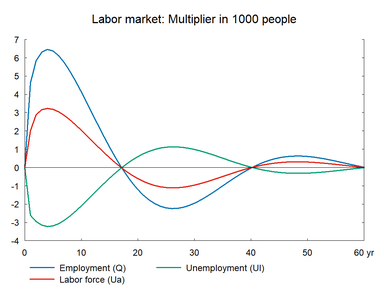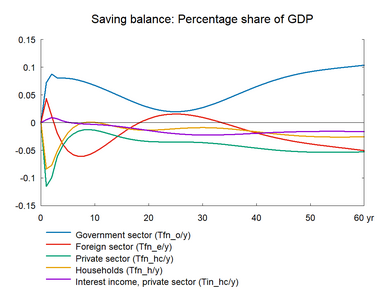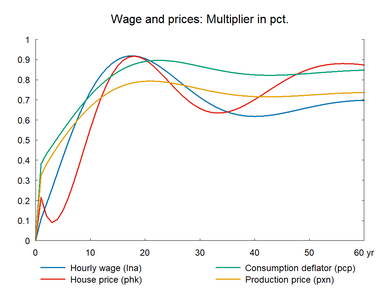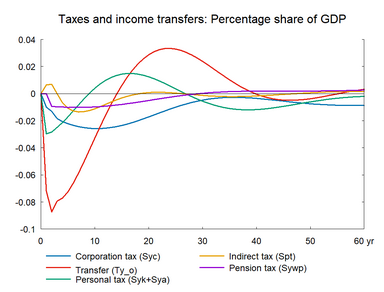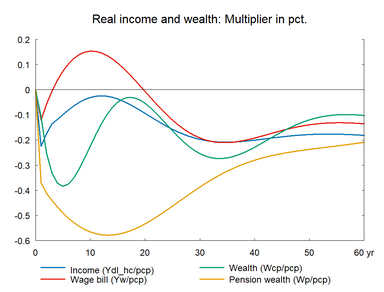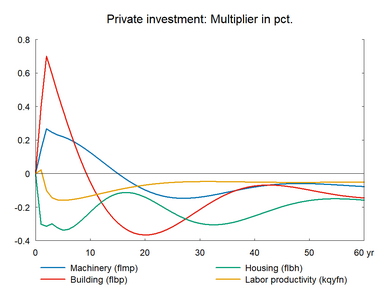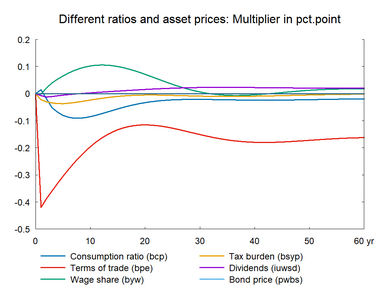The previous sections have focused on various forms of demand shocks, where public expenditures/revenues are changed by 0.1 percent of GDP. Here the focus shifts to foreign prices. The stimulus effect comes from the foreign sector like the case of the foreign demand shock. A rise in foreign prices improves Danish competitiveness and expands exports in the beginning, thus it has the characteristics of a demand shock, and in the long run the employment effect is crowded out.
The table below presents the effect of a permanent 1 percent increase in foreign prices measured in Danish krone. (See experiment)
Table 7. The effect of a permanent increase in foreign prices in Danish krone
| 1. yr | 2. yr | 3. yr | 4. yr | 5. yr | 10. yr | 15. yr | 20. yr | 25. yr | 30. yr | ||
| Million 2010-Dkr. | |||||||||||
| Priv. consumption | fCp | -1388 | -1618 | -1760 | -1832 | -1867 | -1550 | -1362 | -1797 | -2690 | -3637 |
| Pub. consumption | fCo | -49 | -36 | -38 | -41 | -43 | -46 | -31 | 3 | 42 | 66 |
| Investment | fI | 813 | 1036 | 659 | 381 | 201 | -410 | -909 | -1469 | -1920 | -2074 |
| Export | fE | 4014 | 4462 | 4808 | 5018 | 5074 | 3680 | 1236 | -574 | -1038 | -273 |
| Import | fM | -894 | -665 | -651 | -586 | -468 | -205 | -531 | -1207 | -1838 | -2148 |
| GDP | fY | 4220 | 4480 | 4390 | 4262 | 4086 | 2344 | 63 | -1950 | -3056 | -3050 |
| 1000 Persons | |||||||||||
| Employment | Q | 4.62 | 5.84 | 6.31 | 6.46 | 6.37 | 4.13 | 1.11 | -1.21 | -2.21 | -1.95 |
| Unemployment | Ul | -2.61 | -2.95 | -3.15 | -3.23 | -3.19 | -2.09 | -0.58 | 0.60 | 1.11 | 0.99 |
| Percent of GDP | |||||||||||
| Pub. budget balance | Tfn_o/Y | 0.07 | 0.09 | 0.08 | 0.08 | 0.08 | 0.07 | 0.05 | 0.03 | 0.02 | 0.03 |
| Priv. saving surplus | Tfn_hc/Y | -0.12 | -0.10 | -0.06 | -0.04 | -0.03 | -0.01 | -0.03 | -0.03 | -0.04 | -0.04 |
| Balance of payments | Enl/Y | -0.04 | -0.01 | 0.02 | 0.04 | 0.05 | 0.05 | 0.02 | -0.01 | -0.02 | -0.01 |
| Foreign receivables | Wnnb_e/Y | -0.11 | -0.13 | -0.10 | -0.05 | 0.02 | 0.38 | 0.60 | 0.69 | 0.72 | 0.78 |
| Bond debt | Wbd_os_z/Y | -0.11 | -0.22 | -0.31 | -0.40 | -0.48 | -0.81 | -0.97 | -0.98 | -0.92 | -0.87 |
| Percent | |||||||||||
| Capital intensity | fKn/fX | -0.20 | -0.20 | -0.19 | -0.17 | -0.16 | -0.08 | -0.02 | 0.01 | 0.00 | -0.04 |
| Labour intensity | hq/fX | -0.06 | -0.02 | 0.00 | 0.01 | 0.02 | 0.05 | 0.05 | 0.05 | 0.05 | 0.04 |
| User cost | uim | 0.53 | 0.57 | 0.61 | 0.65 | 0.69 | 0.86 | 0.96 | 0.99 | 0.98 | 0.95 |
| Wage | lna | 0.11 | 0.18 | 0.26 | 0.34 | 0.42 | 0.74 | 0.90 | 0.91 | 0.82 | 0.71 |
| Consumption price | pcp | 0.38 | 0.43 | 0.47 | 0.51 | 0.55 | 0.72 | 0.84 | 0.89 | 0.89 | 0.87 |
| Terms of trade | bpe | -0.43 | -0.39 | -0.36 | -0.34 | -0.31 | -0.20 | -0.14 | -0.12 | -0.13 | -0.15 |
| Percentage-point | |||||||||||
| Consumption ratio | bcp | 0.01 | -0.02 | -0.05 | -0.07 | -0.08 | -0.09 | -0.06 | -0.03 | -0.02 | -0.02 |
| Wage share | byw | 0.00 | 0.02 | 0.04 | 0.05 | 0.07 | 0.10 | 0.10 | 0.07 | 0.03 | 0.01 |
The rise in import- and competitive prices improves competitiveness so export and home market shares increase immediately. More exports lead to an expansion of the economy in the same way as described in the first four sections and especially in section 4 on export market expansion. The higher import prices also increase the Danish consumption prices, and this lowers real income and consumption. However, the first-year fall in private consumption does not offset the gain in market share for Danish production. As a result, unemployment begins to fall already in the first year and the lower level of unemployment raises wages relative to the baseline. Eventually, the competitive advantage will be lost and unemployment will return to the baseline. In the long term, Danish wages and prices will increase by approximately 1 percent.
There is an immediate positive impact on imports despite the increase in import prices. The higher import prices reduce imports, but the higher production requires more inputs, which are partly imported. The short-term demand elasticities are relatively high in the import equations. Thus, the positive demand effect dominates and we get a net increase in imports in the short run. The higher production also increases investment in machinery and business buildings in the short run. The immediate effect on housing investment is negative, due to the fall in real income and housing demand. After the initial fall, house price and housing investment start a positive adjustment process as private consumption starts moving back to its baseline.
In the long run, the foreign price increase works like a monetary shock and affects only domestic price levels. Thus, both the foreign and domestic prices increase by 1 percent in relation to the baseline implying that relative prices and hence quantity variables are unaffected in the long run. This property is inherent in the construction of demand equations in ADAM and in the general indexation, which makes public revenues and expenditures react proportionally to nominal changes.
Note that the long-term effect of a permanent change in foreign prices and the long-term effect of a temporary shock to the wage relation, cf. section 17, are similar with respect to the absence of long-run effects on real variables. They are also similar with respect to the long-term effect on public and foreign debt. In both cases there is a long-run effect reflecting the accumulated budget effects in the transition period before equilibrium is reached. They are also quite similar concerning the adjustment process but note that the transitions differ with respect to sign. A temporary positive wage shock triggers a period with unemployment above baseline, while a permanent foreign price increase triggers a period with unemployment below baseline.
The response of exports to the competitive gain peaks gradually, due to among others capacity constraints and lack of inventory. This is captured by an error correction mechanism, and is one of the key features of ADAM. The effect on exports peaks after a few years. This reflects that the short-term price elasticity is lower than the long term price elasticity in the export equations, so that the error correction process makes the initial response in exports less than the response in the following years. After reaching a peak, exports declines as competitiveness deteriorates.
Figure 7. The effect of a permanent increase in foreign prices

